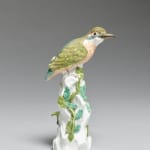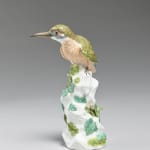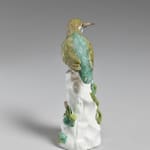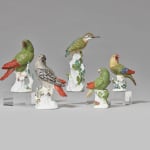



A Very Rare Meissen Kingfisher, Circa 1740
Further images
A Very Rare Meissen Kingfisher modelled by J.J. Kaendler and J.F. Eberlein. Naturalistically painted with green and turquoise wing feathers, the breast of the kingfisher is painted tawny brown enhanced with incised detail for further texture. The kingfisher is perched on a moulded rockwork base with applied leaves and an acorn.
A kingfisher modelled by J.J. Kaendler is recorded in his work report dated September 1735 which states ‘Modelled a kingfisher sitting on a small stone precipice somewhat overgrown with leaves’.
In March 1736, it is recorded that four models of kingfishers were delivered to the Japanese Palace.
Furthermore, mention of another kingfisher modelled by Eberlein appears in his work records dated May 1739.
In the historical inventory records of 1770, two coloured kingfishers are mentioned with a subsequent note which mentions that they were broken during cleaning.
See a similar example in the Metropolitan Museum of Art, New York (1976.155.122)
See a similar example in the Lucy Truman Aldrich Collection in the Rhode Island School of Design Museum of Art, Providence
Provenance
The Baron von Born Collection
Literature
See discussion in Samuel Wittwer, The Gallery of Meissen Animals, Augustus the Strong's Menagerie for the Japanese Palace in Dresden (2006) p. 342.
Join our mailing list
* denotes required fields
We will process the personal data you have supplied in accordance with our privacy policy (available on request). You can unsubscribe or change your preferences at any time by clicking the link in our emails.



